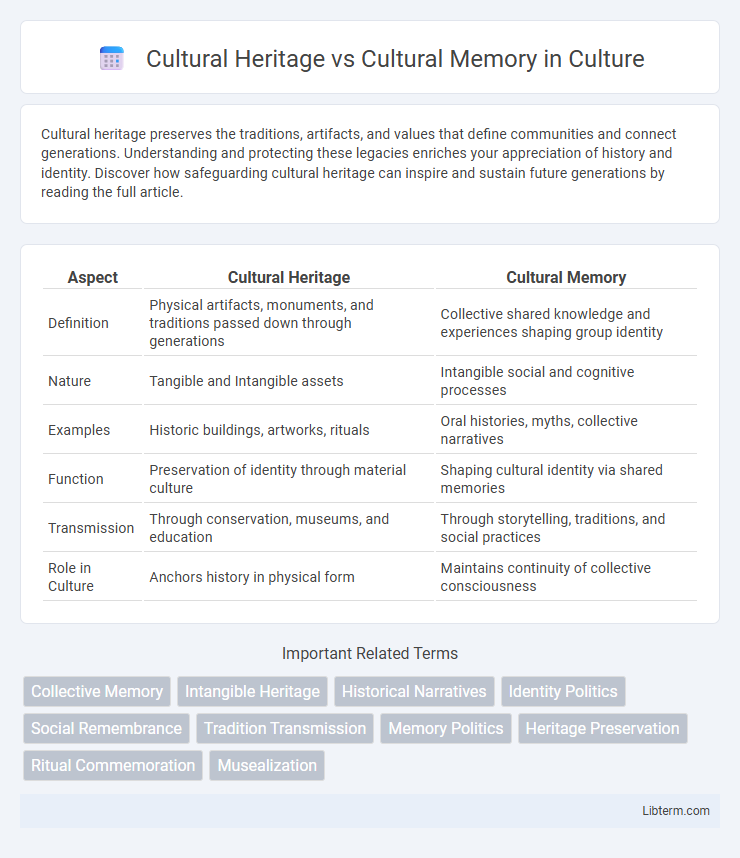Cultural heritage preserves the traditions, artifacts, and values that define communities and connect generations. Understanding and protecting these legacies enriches your appreciation of history and identity. Discover how safeguarding cultural heritage can inspire and sustain future generations by reading the full article.
Table of Comparison
| Aspect | Cultural Heritage | Cultural Memory |
|---|---|---|
| Definition | Physical artifacts, monuments, and traditions passed down through generations | Collective shared knowledge and experiences shaping group identity |
| Nature | Tangible and Intangible assets | Intangible social and cognitive processes |
| Examples | Historic buildings, artworks, rituals | Oral histories, myths, collective narratives |
| Function | Preservation of identity through material culture | Shaping cultural identity via shared memories |
| Transmission | Through conservation, museums, and education | Through storytelling, traditions, and social practices |
| Role in Culture | Anchors history in physical form | Maintains continuity of collective consciousness |
Understanding Cultural Heritage: Definition and Scope
Cultural heritage encompasses tangible and intangible assets inherited from past generations, including monuments, artifacts, traditions, and languages that define a community's identity. It involves preservation, management, and transmission of these resources to ensure their continuity and accessibility for future generations. Understanding cultural heritage requires recognizing its dynamic scope, which integrates historical, social, and cultural dimensions to maintain a living connection between the past and present.
Defining Cultural Memory: Concepts and Frameworks
Cultural memory encompasses the collective ways societies remember and interpret past events through narratives, rituals, and symbols that shape group identity across generations. It operates within theoretical frameworks such as Jan Assmann's distinction between communicative and cultural memory, emphasizing the transmission of shared knowledge beyond immediate lived experience. This dynamic process contrasts with cultural heritage, which refers more concretely to tangible artifacts and sites, while cultural memory focuses on intangible, evolving social practices and representations.
Key Differences Between Heritage and Memory
Cultural heritage consists of tangible artifacts, monuments, and traditions passed down through generations, serving as physical embodiments of a community's identity. Cultural memory, on the other hand, involves the collective recall and interpretation of past experiences that shape societal values and narratives over time. The key difference lies in heritage's material preservation versus memory's evolving and interpretive nature within social contexts.
The Role of Institutions in Preserving Cultural Heritage
Institutions such as museums, archives, and cultural organizations play a critical role in preserving cultural heritage by safeguarding artifacts, documents, and traditions that embody a society's historical identity. These institutions facilitate the transmission of cultural memory by curating exhibitions, supporting research, and promoting public engagement, ensuring that collective knowledge and values are accessible to future generations. Effective preservation strategies involve collaboration between local communities and cultural institutions to maintain authenticity and foster inclusive representation of diverse cultural narratives.
How Societies Construct Collective Cultural Memory
Societies construct collective cultural memory by selectively preserving and commemorating artifacts, rituals, and narratives that embody shared identities and values. Institutions such as museums, schools, and media play crucial roles in curating cultural heritage to reinforce communal bonds and shape historical consciousness. Collective memory evolves through intergenerational transmission, influencing social cohesion and cultural continuity across time.
Cultural Heritage in the Digital Age
Cultural heritage in the digital age encompasses the preservation, digitization, and accessibility of artifacts, traditions, and historical records through advanced technologies such as 3D scanning, virtual reality, and digital archives. This digital transformation enhances global access to cultural heritage sites and objects, enabling education, research, and cultural exchange beyond physical limitations. The integration of digital tools also raises challenges related to authenticity, data preservation, and ethical considerations in representing and managing cultural heritage online.
Intersections: When Heritage Shapes Memory
Cultural heritage serves as a tangible foundation that shapes collective cultural memory through monuments, traditions, and artifacts that embody historical identity. These elements reinforce shared narratives, enabling communities to remember and re-interpret the past across generations. The intersections of cultural heritage and cultural memory are crucial in sustaining identity, as preserved heritage continuously influences how societies construct and preserve their collective memories.
Shifting Narratives: Memory vs Official Heritage
Cultural heritage often represents official narratives preserved through monuments, museums, and sanctioned histories, while cultural memory reflects the lived experiences and collective recollections of communities that may challenge or reinterpret these dominant accounts. Shifting narratives emerge as marginalized voices and alternative memories gain recognition, reshaping understandings of past events and identity. This dynamic tension highlights the evolving nature of heritage and memory, where institutionalized representations intersect with fluid, communal recollections.
Challenges in Safeguarding Heritage and Memory
Safeguarding cultural heritage faces challenges such as environmental degradation, urbanization, and inadequate funding, which threaten the physical preservation of historic sites and artifacts. Cultural memory encounters difficulties in transmission due to generational shifts, globalization, and the dominance of digital media, leading to fragmented or altered collective narratives. Both require integrated strategies that combine conservation techniques with community engagement to ensure authentic preservation and continuation across time.
Future Directions: Bridging Heritage and Memory
Future directions in cultural heritage and cultural memory emphasize integrating digital technologies to enhance preservation and accessibility, fostering interactive experiences that engage diverse communities. Embracing interdisciplinary approaches, such as combining anthropology, history, and information science, supports dynamic interpretations of heritage and memory. Collaborative platforms and participatory projects enable shared ownership, ensuring that evolving cultural narratives remain relevant across generations.
Cultural Heritage Infographic

 libterm.com
libterm.com